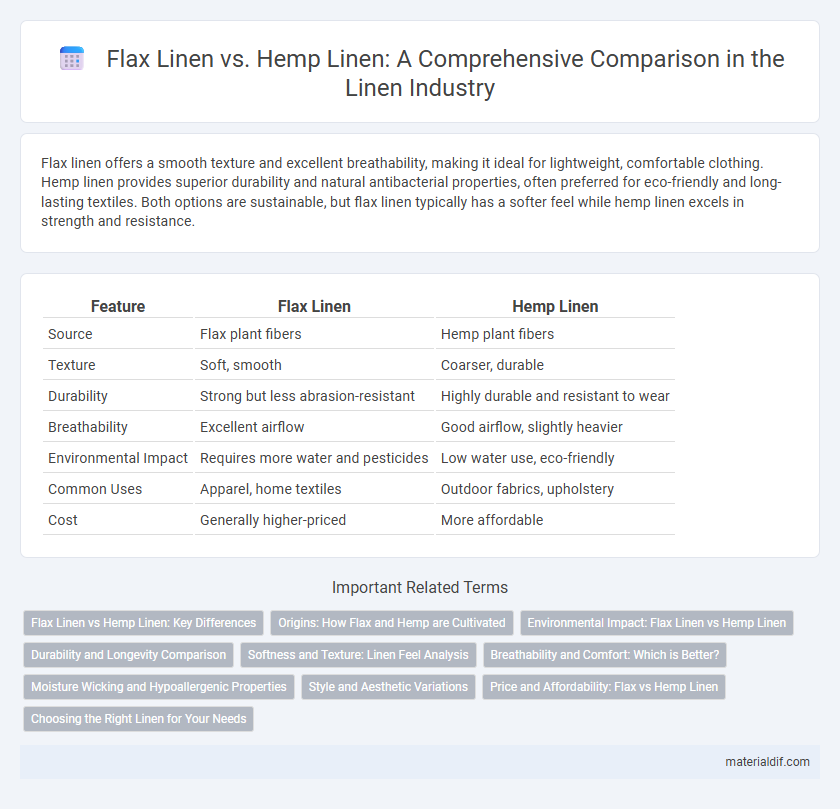Flax linen offers a smooth texture and excellent breathability, making it ideal for lightweight, comfortable clothing. Hemp linen provides superior durability and natural antibacterial properties, often preferred for eco-friendly and long-lasting textiles. Both options are sustainable, but flax linen typically has a softer feel while hemp linen excels in strength and resistance.
Table of Comparison
| Feature | Flax Linen | Hemp Linen |
|---|---|---|
| Source | Flax plant fibers | Hemp plant fibers |
| Texture | Soft, smooth | Coarser, durable |
| Durability | Strong but less abrasion-resistant | Highly durable and resistant to wear |
| Breathability | Excellent airflow | Good airflow, slightly heavier |
| Environmental Impact | Requires more water and pesticides | Low water use, eco-friendly |
| Common Uses | Apparel, home textiles | Outdoor fabrics, upholstery |
| Cost | Generally higher-priced | More affordable |
Flax Linen vs Hemp Linen: Key Differences
Flax linen is derived from the fibers of the flax plant, offering a smooth texture and superior breathability, while hemp linen comes from the hemp plant and is known for its durability and resistance to mold. Flax linen typically has a finer weave and softer feel compared to the coarser, more rugged texture of hemp linen. Both materials are eco-friendly, but flax linen requires more water and labor-intensive processing, whereas hemp is more sustainable with faster growth and minimal pesticide use.
Origins: How Flax and Hemp are Cultivated
Flax linen originates from the flax plant (Linum usitatissimum), cultivated primarily in cooler climates such as Europe and Canada, where its fibers are harvested after the plant matures in about 100 days. Hemp linen is derived from the hemp plant (Cannabis sativa), which thrives in various climates and requires less water and pesticides, making it more sustainable and faster-growing, typically ready for harvest in 90 to 120 days. Both plants undergo retting, a process that separates fibers from the stalk, but flax demands more controlled conditions to ensure high-quality fiber extraction.
Environmental Impact: Flax Linen vs Hemp Linen
Flax linen production typically requires less water and fewer pesticides compared to hemp linen, making it more environmentally sustainable in terms of resource consumption. Hemp linen absorbs more CO2 during cultivation and grows faster, promoting soil health and carbon sequestration. Both fibers are biodegradable and renewable, but hemp's robust growth cycle offers a stronger positive impact on reducing greenhouse gas emissions.
Durability and Longevity Comparison
Flax linen is renowned for its strong natural fibers that offer excellent durability and can last for decades with proper care. Hemp linen surpasses flax in longevity due to its tougher and more resistant fibers, making it highly resistant to wear, UV rays, and mildew. Both materials improve in softness over time, but hemp linen's superior resistance properties make it the preferred choice for heavy-use textiles.
Softness and Texture: Linen Feel Analysis
Flax linen offers a smooth, fine texture with a natural luster, delivering a soft and breathable fabric ideal for clothing and home textiles. Hemp linen, while slightly coarser, provides increased durability and a rustic, textured feel that softens with wear and washing over time. The softness of flax linen is generally preferred for comfort, whereas hemp linen excels in resilience and eco-friendly qualities without sacrificing a pleasant tactile experience.
Breathability and Comfort: Which is Better?
Flax linen offers superior breathability due to its natural fiber structure, allowing excellent air circulation and moisture-wicking properties that keep the skin cool and dry. Hemp linen, while also breathable, tends to be slightly coarser but is praised for its durability and antimicrobial qualities that enhance comfort over long-term use. For those prioritizing softness and lightweight feel, flax linen is generally better, whereas hemp linen excels in strength and sustainable comfort.
Moisture Wicking and Hypoallergenic Properties
Flax linen offers superior moisture-wicking capabilities due to its natural fiber structure, which efficiently absorbs and releases sweat, making it ideal for warm climates and active use. Hemp linen also exhibits excellent moisture-wicking properties but is notably more durable and resistant to mold and bacteria, enhancing its hypoallergenic benefits. Both fibers are hypoallergenic, but hemp linen's antimicrobial qualities provide an edge for sensitive skin and allergy sufferers.
Style and Aesthetic Variations
Flax linen typically offers a smooth, refined texture with a natural luster that enhances classic and elegant styles, making it ideal for formal wear and sophisticated home textiles. Hemp linen features a coarser, more rustic look with visible fibers and a matte finish, lending itself to casual, earthy, and bohemian aesthetics. The distinct weave patterns and durability differences between flax and hemp fibers create unique visual and tactile experiences suited to varied design preferences.
Price and Affordability: Flax vs Hemp Linen
Flax linen generally costs more than hemp linen due to the more intensive processing and cultivation methods involved in flax production. Hemp linen offers a more affordable alternative, benefiting from faster growth cycles and lower pesticide requirements, which reduce overall costs. Consumers seeking budget-friendly linen options often find hemp linen to provide excellent durability and texture at a more accessible price point.
Choosing the Right Linen for Your Needs
Flax linen offers a smooth texture and excellent breathability, making it ideal for lightweight clothing and bedding that require comfort and softness. Hemp linen is more durable and resistant to wear, perfect for heavy-duty textiles or eco-conscious consumers seeking sustainable and long-lasting materials. Selecting between flax and hemp linen depends on prioritizing softness versus durability, with both fibers providing natural, biodegradable options for diverse textile needs.
Flax Linen vs Hemp Linen Infographic

 materialdif.com
materialdif.com